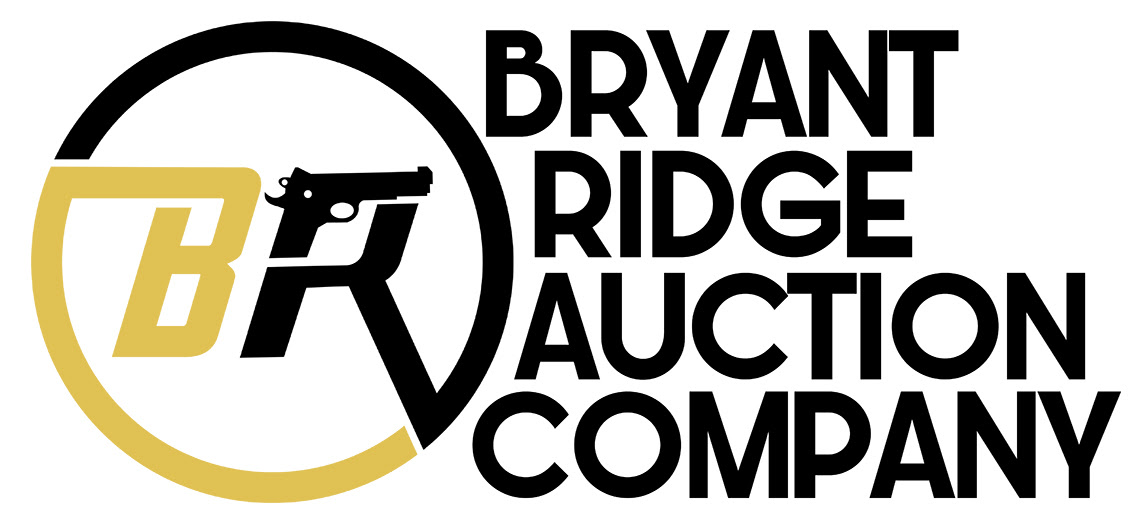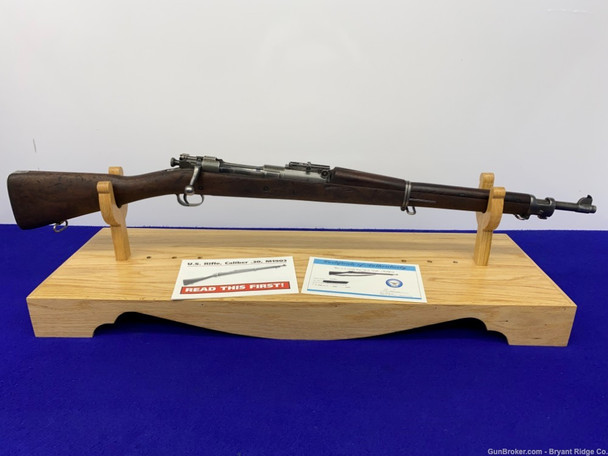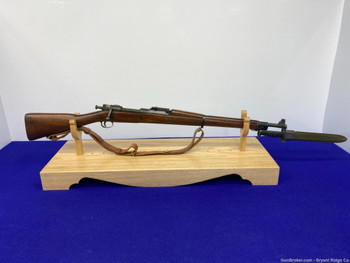Description

Item Description
Bryant Ridge Auction Company is pleased to present this historic bolt-action rifle today for a penny start auction; this is the U.S. Remington Model 1903!
According to the included Certificate of Authenticity, "This is to certify that U.S. Rifle, M1903 with serial number 3131862 was sold to "name" by the Civilian Marksmanship Program on the 16th day of July 2002."
According to the included Certificate of Authenticity, "This is to certify that U.S. Rifle, M1903 with serial number 3131862 was sold to "name" by the Civilian Marksmanship Program on the 16th day of July 2002."
SPECIFICATIONS:
Manufacturer: U.S. Remington
Model: 1903
Serial: 3131862
Date of Manufacture: 1942 (According to the "RA (Flaming Bomb) 5-42" Barrel Stamp)
Caliber: .30-06
Finish: Blue
Barrel Length: 24"
Optics/Sights: Blade Front and Adjustable Ladder Style Rear with Sliding Gradient
Stock/Grips: Smooth Straight Grip Wood Stock
Action: Bolt
Markings: Standard / The top of the receiver ring is stamped "U.S./Remington/Model 1903/Serial No.” The barrel is stamped "RA (Flaming Bomb) 5-42".
Bryant Ridge's Analysis:
The "U.S. Rifle, Caliber .30, Model 1903", also known as the "Springfield" or the "'03", has served the U.S. military for a long time and with great success. It is considered one of the best bolt-action military rifles of all time. The rifle was manufactured by Springfield Armory from 1903 to the late 1930s, and also at Rock Island Arsenal from 1903 to 1913 and again from 1917 until just after World War I. Despite the production of large numbers of "American Enfields" during World War I to supplement the supply of Springfield rifles, the "Springfield '03" remained the standard U.S. military service rifle until the semi-automatic M1 "Garand" rifle was adopted in 1936. However, even after the adoption of the M1, the '03 remained the primary American service rifle until production of the Garand could meet the demand.
During the start of World War II, the British suffered a great loss at Dunkirk. Thousands of rifles were left behind in France when British troops were evacuated to England, which put the British in a dangerous situation. The British government reached out to the United States for help in acquiring new arms. They explored various possibilities, including discussions with Remington Arms Company about producing rifles under a British contract. An idea was suggested to use the old manufacturing equipment in storage at Rock Island Arsenal to produce rifles for the British. The U.S. War Department agreed to lease the equipment to Remington and also provided around 600,000 walnut rifle stock “blanks” that were in storage. Remington agreed to pay for the stock blanks by producing cartridges for the U.S. government in future contracts.
During World War II, the British requested changes to the proposed Remington .303 rifles, including modifications to use the standard .303 British cartridge and alterations to the stock and muzzle to allow for use of the Lee-Enfield No. 4, Mark I bayonet. The grip of the stock was also modified to mimic the “hook” type pistol-grip found on the Lee-Enfield. Some changes were easy to make, while others were more complex. However, due to the passage of Lend-Lease legislation and the British's pressing need for new rifles, the proposed Remington .303 rifles were no longer necessary. Consequently, the British contracts were canceled in September 1941 before any rifles were manufactured.
The U.S. Ordnance Department immediately contracted with Remington for the M1903 rifles in order to equip the rapidly expanding U.S. armed forces. The U.S. government ordered 134,000 rifles of the same type from Remington on the same day that the British contracts were canceled. By this time, Remington was ready to start producing the rifles on a limited scale. The company was given the serial number block of “3,000,000 to 3,599,999” for its initial production. Ten “trial production” rifles were produced soon after the contract was granted, and the first 1,273 production rifles were delivered in November 1941. Initially, these were supposed to be designated as "M1903A1", which would have required full pistol-grip ("Type C") stocks. However, the large supply of stock blanks acquired by Remington were primarily suited for fabrication of the straight-grip type of stock, so the M1903 nomenclature was not changed. Interestingly, some internal Remington documents during this period refer to the rifles as “M1903 Modified.”
The Remington M1903 rifles produced in the early days were quite similar to the ones created by Rock Island towards the end of World War I. They featured well-crafted straight-grip (“Type S”) stocks with “grasping grooves” and handguards that had a prominent sight-protecting “hump.” The rifles were finished with black-tinted Parkerizing and utilized the same type of heat treatment as the late-production Springfield M1903s. The receiver rings of the new Remington ’03s had the stamp “U.S./Remington/Model 1903/Serial No.,” while the barrels had the marking of “RA” (Remington Arms) along with the month and year of manufacture. The stocks were stamped with an Ordnance Department escutcheon (“crossed cannons”) and the initials “RLB” on the left side below the magazine cut-off recess, where “RLB” represented Col. Roy L. Bowlin, the Chief of the Rochester Ordnance District.
Following the attack on Pearl Harbor, the U.S. government placed increased orders for the Remington M1903s. The initial order of 134,000 was later increased to 308,000 and then further raised to 508,000 with a production target of 2,000 daily rifles. However, the company faced a dilemma due to a significant increase in demand and production problems caused by the worn-out Rock Island machinery.
Model: 1903
Serial: 3131862
Date of Manufacture: 1942 (According to the "RA (Flaming Bomb) 5-42" Barrel Stamp)
Caliber: .30-06
Finish: Blue
Barrel Length: 24"
Optics/Sights: Blade Front and Adjustable Ladder Style Rear with Sliding Gradient
Stock/Grips: Smooth Straight Grip Wood Stock
Action: Bolt
Markings: Standard / The top of the receiver ring is stamped "U.S./Remington/Model 1903/Serial No.” The barrel is stamped "RA (Flaming Bomb) 5-42".
Bryant Ridge's Analysis:
The "U.S. Rifle, Caliber .30, Model 1903", also known as the "Springfield" or the "'03", has served the U.S. military for a long time and with great success. It is considered one of the best bolt-action military rifles of all time. The rifle was manufactured by Springfield Armory from 1903 to the late 1930s, and also at Rock Island Arsenal from 1903 to 1913 and again from 1917 until just after World War I. Despite the production of large numbers of "American Enfields" during World War I to supplement the supply of Springfield rifles, the "Springfield '03" remained the standard U.S. military service rifle until the semi-automatic M1 "Garand" rifle was adopted in 1936. However, even after the adoption of the M1, the '03 remained the primary American service rifle until production of the Garand could meet the demand.
During the start of World War II, the British suffered a great loss at Dunkirk. Thousands of rifles were left behind in France when British troops were evacuated to England, which put the British in a dangerous situation. The British government reached out to the United States for help in acquiring new arms. They explored various possibilities, including discussions with Remington Arms Company about producing rifles under a British contract. An idea was suggested to use the old manufacturing equipment in storage at Rock Island Arsenal to produce rifles for the British. The U.S. War Department agreed to lease the equipment to Remington and also provided around 600,000 walnut rifle stock “blanks” that were in storage. Remington agreed to pay for the stock blanks by producing cartridges for the U.S. government in future contracts.
During World War II, the British requested changes to the proposed Remington .303 rifles, including modifications to use the standard .303 British cartridge and alterations to the stock and muzzle to allow for use of the Lee-Enfield No. 4, Mark I bayonet. The grip of the stock was also modified to mimic the “hook” type pistol-grip found on the Lee-Enfield. Some changes were easy to make, while others were more complex. However, due to the passage of Lend-Lease legislation and the British's pressing need for new rifles, the proposed Remington .303 rifles were no longer necessary. Consequently, the British contracts were canceled in September 1941 before any rifles were manufactured.
The U.S. Ordnance Department immediately contracted with Remington for the M1903 rifles in order to equip the rapidly expanding U.S. armed forces. The U.S. government ordered 134,000 rifles of the same type from Remington on the same day that the British contracts were canceled. By this time, Remington was ready to start producing the rifles on a limited scale. The company was given the serial number block of “3,000,000 to 3,599,999” for its initial production. Ten “trial production” rifles were produced soon after the contract was granted, and the first 1,273 production rifles were delivered in November 1941. Initially, these were supposed to be designated as "M1903A1", which would have required full pistol-grip ("Type C") stocks. However, the large supply of stock blanks acquired by Remington were primarily suited for fabrication of the straight-grip type of stock, so the M1903 nomenclature was not changed. Interestingly, some internal Remington documents during this period refer to the rifles as “M1903 Modified.”
The Remington M1903 rifles produced in the early days were quite similar to the ones created by Rock Island towards the end of World War I. They featured well-crafted straight-grip (“Type S”) stocks with “grasping grooves” and handguards that had a prominent sight-protecting “hump.” The rifles were finished with black-tinted Parkerizing and utilized the same type of heat treatment as the late-production Springfield M1903s. The receiver rings of the new Remington ’03s had the stamp “U.S./Remington/Model 1903/Serial No.,” while the barrels had the marking of “RA” (Remington Arms) along with the month and year of manufacture. The stocks were stamped with an Ordnance Department escutcheon (“crossed cannons”) and the initials “RLB” on the left side below the magazine cut-off recess, where “RLB” represented Col. Roy L. Bowlin, the Chief of the Rochester Ordnance District.
Following the attack on Pearl Harbor, the U.S. government placed increased orders for the Remington M1903s. The initial order of 134,000 was later increased to 308,000 and then further raised to 508,000 with a production target of 2,000 daily rifles. However, the company faced a dilemma due to a significant increase in demand and production problems caused by the worn-out Rock Island machinery.
To meet the ambitious production schedules, representatives from the Ordnance Department visited the factory and recommended reducing the amount of metal polishing, eliminating unnecessary machining, and relaxing non-critical tolerances. The company was allowed to drill a gas escape hole into the left side of the receiver, as had been done at the Springfield Armory since 1936.
As production of Remington's firearms continued, changes were made to the original specifications in order to decrease production time. Some of these changes were subtle, while others were quite obvious. For example, they removed the "lightning cuts" on both sides of the rear sight base, eliminated the small gas escape hole on the right side of the receiver, and drilled the rear guard screw hole completely through the receiver tang. Additionally, they authorized the removal of the "grasping grooves" on the stock and other features to reduce production time for the stock and handguard. They also began using stamped components to replace costly and time-consuming milled parts. The stamped parts included the lower barrel band (and band spring), butt swivel, magazine follower, and eventually, a one-piece trigger guard/magazine assembly.
During the first quarter of 1942, the original specifications for Remington rifles underwent significant changes, resulting in noticeable differences from the early production models. These modified rifles were referred to as "M1903 Modified," although the term may have been used as early as November 1941. Today, this term is widely used to distinguish these modified Remington rifles from the original '03 rifles, which were finely crafted during the first few months of production. In this article, we will use the "Modified" designation to differentiate this variant from earlier and later versions. It is important to note that production shortcuts were gradually phased in over time. Some of the earlier "M1903 Modified" rifles will have fewer stamped parts, whereas later production will feature more stamped components.
Remington produced both the original and modified versions of rifles at the fastest possible rate during the war. These rifles were used for training and used in combat early on. However, most of the initial production of Remington rifles was sent to military requirements, similar to "Lend-Lease" for the Commonwealth allies. Many of these rifles were supplied to New Zealand forces. Additionally, it has been reported that the U.S. Marine Corps used a number of Remington rifles in some of the initial Pacific campaigns. Despite the fact that Remington '03 rifles showed several manufacturing shortcuts, they had a sturdy action and were all classified as "high number" rifles.
Contents:
This example will ship with the serial matching COA from CMP and the manual pictured above!
Return Policy:
We gladly offer a 3 day unfired inspection policy from the time that the firearm is delivered to your FFL. Refunds are available for all qualifying orders.
Shipping Details
Handgun Standard Shipping $50.00
Long Gun Standard Shipping $70.00
Any orders placed with magazines that are not compliant with your state, county, or city regulations will not ship with your order.
















